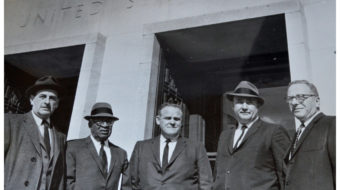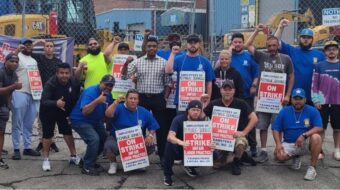PINELLAS PARK, Fla. (PAI) — Just about two years ago, plumber Charles “Mike” Morrison was helping dig a trench in a Pinellas Park, Fla. But the trench had straight sides, not sloping sides, and B&B Plumbing didn’t construct a safety box for him to work in.
One wall collapsed on him — equal to 2,700 pounds of dirt — and buried him up to just beneath his arms, stepdaughter Michelle Lewis says. Twelve of his ribs plus his pelvis were broken and he was bleeding internally. Rescue teams were told to get out of the trench; it might collapse on them, too. B&B gave the dying man an oxygen mask to breathe into — and a shovel to dig himself out. He died, still trying to get out, in the trench.
The Occupational Safety and Health Administration fined B&B $21,000 for five workplace safety violations.
They stand for five ways her stepfather should have survived, Lewis says.
Morrison was one of the 5,734 workers who died on the job in 2005, and OSHA’s fine against B&B is typical of its penalties when such deaths occur. Both trends are spotlighted in the AFL-CIO’s latest annual report on job safety and health nationwide.
“A combination of too few OSHA inspectors and low penalties makes the threat of an OSHA inspection hollow for too many employers,” the federation reported. With the low staff numbers, one inspector for every 63,670 workers, it would take OSHA 133 years to inspect each workplace in the U.S. just once.
The report says deaths on the job declined by 30 from 2004 to 2005. That’s despite a spike in coal mine deaths at the Sago Mine in West Virginia and elsewhere: from 22 in 2004 to 47 last year.
“Under Bush, regulatory activity at OSHA has ground to a halt,” the report says. “Dozens of OSHA and MSHA [Mine Safety and Health Administration] standards were pulled from the regulatory agenda, including MSHA standards on mine rescue teams, self-contained self-rescue devices, and escape ways and refuges which may have helped to prevent the fatalities at Sago.
“Some new mine safety rules are now being developed and issued,” the report continues, “but only as a result of legislation enacted in the wake of the Sago disaster.”
The report also said any new and emerging hazards for workers, like bioterrorism and pandemic flu, are inadequately addressed.
The federation said the Bush regime prefers “voluntary” programs where companies discuss worker safety standards with the agencies and get “guidance” on how to keep workplaces safe. In return, inspections stop, and that won’t work, the federation said.
Other key data from the report include the following:
• On average, 16 workers were fatally injured and more than 12,000 workers were injured or made ill each day of 2005. That does not include deaths of retired or disabled workers from occupational diseases, such as asbestosis or black lung disease.
• The worst fatality rate was in Wyoming, with 16.8 deaths per 100,000 workers in 2005, more than four times the national rate (4.1). It was followed by Montana (10.3), Mississippi (8.9), Alaska (8.2), South Dakota (7.5) and South Carolina (6.7). The lowest fatality rates were in Rhode Island (1.1 per 100,000), Vermont (2.0), Maine (2.2), Hawaii (2.3), Massachusetts (2.3) and Michigan (2.3). Either the number or rate of job fatalities rose in 24 states, with the biggest jumps in Mississippi, Montana and South Dakota.
• Construction led all occupations in fatal injuries in 2005, with 1,192, followed by transportation and warehousing (885). Fishers and fishing workers had the worst fatality rate (118.4 per 100,000), followed by loggers (92.9) and pilots and flight engineers (66.9).
The numbers won’t bring Mike Morrison back, but his stepdaughter will campaign for tougher job safety laws so other families don’t have to go through the same grief.
“Whether people are union or nonunion, Republican or Democratic, everyone needs to be protected,” she said. “I won’t rest until people realize the bottom line isn’t about dollars, it’s about human loss.”









